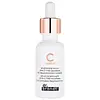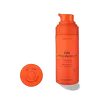What's inside
What's inside
 Key Ingredients
Key Ingredients

 Benefits
Benefits

 Concerns
Concerns

 Ingredients Side-by-side
Ingredients Side-by-side

Water
Skin ConditioningTetrahexyldecyl Ascorbate
AntioxidantC9-12 Alkane
SolventPPG-24-Glycereth-24
EmulsifyingPropanediol
SolventGlycerin
HumectantPotassium Cetyl Phosphate
EmulsifyingCaprylic/Capric Triglyceride
MaskingGlyceryl Stearate
EmollientPEG-100 Stearate
1,2-Hexanediol
Skin ConditioningHexylresorcinol
AntimicrobialEthyl Linoleate
EmollientPlankton Extract
Skin ConditioningBioflavonoids
Skin ConditioningGlucose
HumectantLecithin
EmollientLavandula Angustifolia Oil
MaskingLavandula Hybrida Oil
EmollientCitric Acid
BufferingCitrus Aurantium Dulcis Peel Extract
Emulsion StabilisingTocopheryl Acetate
AntioxidantXanthan Gum
EmulsifyingCoco-Caprylate/Caprate
EmollientAcrylates/C10-30 Alkyl Acrylate Crosspolymer
Emulsion StabilisingPhenethyl Alcohol
MaskingPolyglyceryl-6 Polyricinoleate
EmulsifyingPentylene Glycol
Skin ConditioningTocopherol
AntioxidantAminomethyl Propanol
BufferingDisodium EDTA
Linalyl Acetate
MaskingChlorogenic Acids
AntioxidantSodium Ascorbate
AntioxidantPhenoxyethanol
PreservativeLinalool
PerfumingLimonene
PerfumingGeraniol
PerfumingWater, Tetrahexyldecyl Ascorbate, C9-12 Alkane, PPG-24-Glycereth-24, Propanediol, Glycerin, Potassium Cetyl Phosphate, Caprylic/Capric Triglyceride, Glyceryl Stearate, PEG-100 Stearate, 1,2-Hexanediol, Hexylresorcinol, Ethyl Linoleate, Plankton Extract, Bioflavonoids, Glucose, Lecithin, Lavandula Angustifolia Oil, Lavandula Hybrida Oil, Citric Acid, Citrus Aurantium Dulcis Peel Extract, Tocopheryl Acetate, Xanthan Gum, Coco-Caprylate/Caprate, Acrylates/C10-30 Alkyl Acrylate Crosspolymer, Phenethyl Alcohol, Polyglyceryl-6 Polyricinoleate, Pentylene Glycol, Tocopherol, Aminomethyl Propanol, Disodium EDTA, Linalyl Acetate, Chlorogenic Acids, Sodium Ascorbate, Phenoxyethanol, Linalool, Limonene, Geraniol
Water
Skin ConditioningPropanediol
SolventPseudozyma Epicola/Camellia Sinensis Seed Oil Ferment Extract Filtrate
HumectantTetrahexyldecyl Ascorbate
AntioxidantGlycerin
HumectantCaprylic/Capric Triglyceride
MaskingC9-12 Alkane
SolventPEG-100 Stearate
Glyceryl Stearate
EmollientAcetyl Zingerone
AntioxidantAdansonia Digitata Fruit Extract
EmollientGalactomyces Ferment Filtrate
HumectantTerminalia Ferdinandiana Fruit Extract
AntioxidantPersea Gratissima Fruit Extract
EmollientPolygonum Cuspidatum Root Extract
AntioxidantAcetyl Tetrapeptide-2
Skin ConditioningBenzyl Alcohol
PerfumingHydroxyethyl Acrylate/Sodium Acryloyldimethyl Taurate Copolymer
Emulsion StabilisingDimethicone
EmollientPolyglyceryl-6 Polyricinoleate
EmulsifyingTocopheryl Acetate
AntioxidantPolyisobutene
Acrylates/C10-30 Alkyl Acrylate Crosspolymer
Emulsion StabilisingCaprylhydroxamic Acid
Xanthan Gum
EmulsifyingCoco-Caprylate/Caprate
EmollientTrisodium Ethylenediamine Disuccinate
PEG-7 Trimethylolpropane Coconut Ether
EmulsifyingPhenoxyethanol
PreservativeSorbitan Isostearate
EmulsifyingSodium Benzoate
MaskingCaprylyl Glycol
EmollientPotassium Sorbate
PreservativeSodium Hydroxide
BufferingCitric Acid
BufferingWater, Propanediol, Pseudozyma Epicola/Camellia Sinensis Seed Oil Ferment Extract Filtrate, Tetrahexyldecyl Ascorbate, Glycerin, Caprylic/Capric Triglyceride, C9-12 Alkane, PEG-100 Stearate, Glyceryl Stearate, Acetyl Zingerone, Adansonia Digitata Fruit Extract, Galactomyces Ferment Filtrate, Terminalia Ferdinandiana Fruit Extract, Persea Gratissima Fruit Extract, Polygonum Cuspidatum Root Extract, Acetyl Tetrapeptide-2, Benzyl Alcohol, Hydroxyethyl Acrylate/Sodium Acryloyldimethyl Taurate Copolymer, Dimethicone, Polyglyceryl-6 Polyricinoleate, Tocopheryl Acetate, Polyisobutene, Acrylates/C10-30 Alkyl Acrylate Crosspolymer, Caprylhydroxamic Acid, Xanthan Gum, Coco-Caprylate/Caprate, Trisodium Ethylenediamine Disuccinate, PEG-7 Trimethylolpropane Coconut Ether, Phenoxyethanol, Sorbitan Isostearate, Sodium Benzoate, Caprylyl Glycol, Potassium Sorbate, Sodium Hydroxide, Citric Acid
Ingredients Explained
These ingredients are found in both products.
Ingredients higher up in an ingredient list are typically present in a larger amount.
Acrylates/C10-30 Alkyl Acrylate Crosspolymer is a synthetic polymer. It is used to thicken and improve the texture of products. Due to its properties, it can prevent water and oil ingredients from separating.
C9-12 Alkane is synethically created using alkanes, or paraffins. It is added to products as a solvent. This means its main purpose is to help dissolve ingredients and create even texture.
This ingredient is an emollient, solvent, and texture enhancer. It is considered a skin-softener by helping the skin prevent moisture loss.
It helps thicken a product's formula and makes it easier to spread by dissolving clumping compounds.
Caprylic Triglyceride is made by combining glycerin with coconut oil, forming a clear liquid.
While there is an assumption Caprylic Triglyceride can clog pores due to it being derived from coconut oil, there is no research supporting this.
Learn more about Caprylic/Capric TriglycerideCitric Acid is an alpha hydroxy acid (AHA) naturally found in citrus fruits like oranges, lemons, and limes.
Like other AHAs, citric acid can exfoliate skin by breaking down the bonds that hold dead skin cells together. This helps reveal smoother and brighter skin underneath.
However, this exfoliating effect only happens at high concentrations (20%) which can be hard to find in cosmetic products.
Due to this, citric acid is usually included in small amounts as a pH adjuster. This helps keep products slightly more acidic and compatible with skin's natural pH.
In skincare formulas, citric acid can:
While it can provide some skin benefits, research shows lactic acid and glycolic acid are generally more effective and less irritating exfoliants.
Most citric acid used in skincare today is made by fermenting sugars (usually from molasses). This synthetic version is identical to the natural citrus form but easier to stabilize and use in formulations.
Read more about some other popular AHA's here:
Learn more about Citric AcidCoco-Caprylate/Caprate is created from fatty coconut alcohol, caprylic acid, and capric acid.
It is a lightweight emollient. Emollients create a thin barrier on the skin to trap moisture in. This helps keep your skin hydrated and soft.
Once applied, Coco-Caprylate/Caprate is absorbed quickly and leaves a silky feel.
Coco-Caprylate/Caprate may not be fungal acne safe.
Learn more about Coco-Caprylate/CaprateGlycerin is already naturally found in your skin. It helps moisturize and protect your skin.
A study from 2016 found glycerin to be more effective as a humectant than AHAs and hyaluronic acid.
As a humectant, it helps the skin stay hydrated by pulling moisture to your skin. The low molecular weight of glycerin allows it to pull moisture into the deeper layers of your skin.
Hydrated skin improves your skin barrier; Your skin barrier helps protect against irritants and bacteria.
Glycerin has also been found to have antimicrobial and antiviral properties. Due to these properties, glycerin is often used in wound and burn treatments.
In cosmetics, glycerin is usually derived from plants such as soybean or palm. However, it can also be sourced from animals, such as tallow or animal fat.
This ingredient is organic, colorless, odorless, and non-toxic.
Glycerin is the name for this ingredient in American English. British English uses Glycerol/Glycerine.
Learn more about GlycerinGlyceryl Stearate is a mix of glycerin and stearic acid.
It is used to stabilize the mixing of water and oil ingredients. By preventing these ingredients from separating, it can help elongate shelf life. It can also help thicken the product's texture.
As an emollient, it helps soften skin and supports barrier-replenishing ingredients.
In cosmetics, Glyceryl Stearate is often made from vegetable oils or synthetically produced.
This ingredient may not be fungal-acne safe
Fun fact: The human body also creates Glyceryl Stearate naturally.
Learn more about Glyceryl StearatePeg-100 Stearate is an emollient and emulsifier. As an emollient, it helps keep skin soft by trapping moisture in. On the other hand, emulsifiers help prevent oil and water from separating in a product.
PEGS are a hydrophilic polyether compound . There are 100 ethylene oxide monomers in Peg-100 Stearate. Peg-100 Stearate is polyethylene glycol ester of stearic acid.
Phenoxyethanol is a preservative that has germicide, antimicrobial, and aromatic properties. Studies show that phenoxyethanol can prevent microbial growth. By itself, it has a scent that is similar to that of a rose.
It's often used in formulations along with Caprylyl Glycol to preserve the shelf life of products.
Polyglyceryl-6 Polyricinoleate isn't fungal acne safe.
Propanediol is an all-star ingredient. It softens, hydrates, and smooths the skin.
It’s often used to:
Propanediol is not likely to cause sensitivity and considered safe to use. It is derived from corn or petroleum with a clear color and no scent.
Learn more about PropanediolTetrahexyldecyl Ascorbate (THD) is a stable and oil-soluble form of Vitamin C.
THD is special in that it has the ability to travel deeper into skin than traditional ascorbic acid while maintaining the same skin benefits (double win!).
Because it’s oil-soluble, THD dives deep into your skin’s fatty layers (think ceramides and cholesterol) to fight off the kind of free radicals that mess with your skin barrier. This makes it a great pair with water-based vitamin C (ascorbic acid) that mainly works on the surface.
Even at just 0.1%, THD is already showing great antioxidant activity. When used up to 2%, it helps keep your skin happy and calm, especially when it’s stressed from pollution or sun.
Want to fade dark spots or tackle hyperpigmentation? You’ll want 5% or more. Pairing it with brightening buddies like niacinamide or licorice root gives even better results. One study even used 30% THD with other brighteners and saw real results on stubborn discoloration, even in melasma-prone skin.
A note on THD: It’s has a slightly silky, oily texture and usually shows up colorless or pale yellow (though the exact shade can vary by supplier).
While you can sneak it into water-based formulas, it really shines when paired with silicones or oils, which help your skin soak it up better.
THD is pretty stable, but it’s still vulnerable to degradation like ascorbic acid. Too much light or heat (above 113°F / 45°C) can break it down over time. Go for dark and opaque packaging that keeps it safe and shady!
Read more about other types of Vitamin C:
Learn more about Tetrahexyldecyl AscorbateTocopheryl Acetate is AKA Vitamin E. It is an antioxidant and protects your skin from free radicals. Free radicals damage the skin by breaking down collagen.
One study found using Tocopheryl Acetate with Vitamin C decreased the number of sunburned cells.
Tocopheryl Acetate is commonly found in both skincare and dietary supplements.
Learn more about Tocopheryl AcetateWater. It's the most common cosmetic ingredient of all. You'll usually see it at the top of ingredient lists, meaning that it makes up the largest part of the product.
So why is it so popular? Water most often acts as a solvent - this means that it helps dissolve other ingredients into the formulation.
You'll also recognize water as that liquid we all need to stay alive. If you see this, drink a glass of water. Stay hydrated!
Learn more about WaterXanthan gum is used as a stabilizer and thickener within cosmetic products. It helps give products a sticky, thick feeling - preventing them from being too runny.
On the technical side of things, xanthan gum is a polysaccharide - a combination consisting of multiple sugar molecules bonded together.
Xanthan gum is a pretty common and great ingredient. It is a natural, non-toxic, non-irritating ingredient that is also commonly used in food products.
Learn more about Xanthan Gum